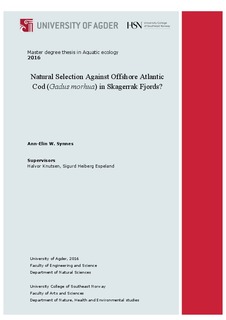Natural selection against offshore Atlantic cod (Gadus morhua) in Skagerrak fjords?
Master thesis
Permanent lenke
http://hdl.handle.net/11250/2409219Utgivelsesdato
2016Metadata
Vis full innførselSamlinger
Sammendrag
The marine environment was previously presumed to be demographically “open”, and marineorganisms were thought to have pronounced gene flow over vast areas due to their potentialof dispersal during early life stages. However, recent studies have suggested a degree of selfrecruitmentwithin segments of coastal and offshore areas for several marine species. Two ofthe forces acting on this structuring are retention of early life stages and homing of adultindividuals. This study looks at the distribution of early life stages of the Atlantic cod (Gadusmorhua) in two Norwegian fjords divided into inshore-offshore transects, and study if thefrequency of coastal cod and North Sea cod is changing over the season. In the early autumn,both fjords end up with the same pattern, with the highest frequency of genotypes resemblingthe North Sea in cod eggs in the outer stations, and genotypes probably being coastal coddominating the inner stations. There was, however, a difference in how this pattern emerged.Tvedestrand seemed to have a more open system, with more mixing of the cod eggs than whatwas found in Topdalsfjord. In Topdalsfjord there seemed to be a higher retention in the innerbasins, and generally there were less North Sea cod eggs and juvenile than what was found inTvedestrand. The results cannot conclude if the pattern that emerges is caused by selectionagainst fish transported into non-native areas, but the results are discussed in light of newresearch findings.
Beskrivelse
Master's thesis Aquatic Ecology BIO500 - University of Agder 2016
